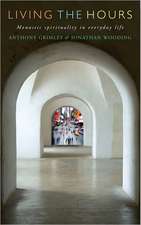Invisible City: The Architecture of Devotion in Seventeenth Century Neapolitan Convents
Autor Helen Hillsen Limba Engleză Hardback – 12 feb 2004
Preț: 628.99 lei
Preț vechi: 901.75 lei
-30% Nou
Puncte Express: 943
Preț estimativ în valută:
120.39€ • 125.21$ • 100.89£
120.39€ • 125.21$ • 100.89£
Carte tipărită la comandă
Livrare economică 03-08 martie
Preluare comenzi: 021 569.72.76
Specificații
ISBN-13: 9780195117745
ISBN-10: 0195117743
Pagini: 320
Ilustrații: 30pp halftone plates & 8pp colour plates
Dimensiuni: 234 x 160 x 28 mm
Greutate: 0.6 kg
Editura: Oxford University Press
Colecția OUP USA
Locul publicării:New York, United States
ISBN-10: 0195117743
Pagini: 320
Ilustrații: 30pp halftone plates & 8pp colour plates
Dimensiuni: 234 x 160 x 28 mm
Greutate: 0.6 kg
Editura: Oxford University Press
Colecția OUP USA
Locul publicării:New York, United States
Recenzii
Hills' extraordinary study is a nuanced and innovative incarnation of the secular city from its sacred recesses that should have broad appeal and wide-ranging influence. Invisible City is a brilliant, stunning book.
... a fascinating study of the foundation and development of convent life and architecture in 17th century Naples.
Helen Hills's Invisible City illuminates the rich and introverted world of seventeenth-century Neapolitan convents. In this ground-breaking study, Professor Hills brings early modern Naples to life. Her sensitive reading of architecture restores to the nuns their own voice and reveals the complex intersection of social class, gender, and urban politics. Helen Hills demonstrates that, as institutional patrons, the aristocratic women in the conventual communities of Naples were by no means subservient to a dominant religious patriarchy, but boldly asserted their own distinctive social, spiritual and aesthetic values. In the process, they contributed in no small measure to shaping one of the pre-eminent urban centers of seventeenth- and eighteenth-century Europe.
Professor Hills's book is outstanding for its richly nuanced examination of the relation between architecture and gendered identity in Neapolitan convents. Demonstrating how convents formed an integral part of the spiritual, political, economic, and urban ambience of Naples, she makes an important contribution to our understanding of female monasticism and its social functions.
Invisible City examines the social and moral impulses that put nuns into Neapolitan convents and the buildings that housed them, presenting them as intertwined components of a culture of aristocratic virginity. Massively researched and bristling with ideas expressed in vigorous, vivid prose, Helen Hills's brilliant book explores the paradox that, invisible in their unworldly cloisters, nuns built visually imposing vantage points for surveying the family palaces and the secular city that they had abandoned physically but in which they retained powerful cultural influence.
... a fascinating study of the foundation and development of convent life and architecture in 17th century Naples.
Helen Hills's Invisible City illuminates the rich and introverted world of seventeenth-century Neapolitan convents. In this ground-breaking study, Professor Hills brings early modern Naples to life. Her sensitive reading of architecture restores to the nuns their own voice and reveals the complex intersection of social class, gender, and urban politics. Helen Hills demonstrates that, as institutional patrons, the aristocratic women in the conventual communities of Naples were by no means subservient to a dominant religious patriarchy, but boldly asserted their own distinctive social, spiritual and aesthetic values. In the process, they contributed in no small measure to shaping one of the pre-eminent urban centers of seventeenth- and eighteenth-century Europe.
Professor Hills's book is outstanding for its richly nuanced examination of the relation between architecture and gendered identity in Neapolitan convents. Demonstrating how convents formed an integral part of the spiritual, political, economic, and urban ambience of Naples, she makes an important contribution to our understanding of female monasticism and its social functions.
Invisible City examines the social and moral impulses that put nuns into Neapolitan convents and the buildings that housed them, presenting them as intertwined components of a culture of aristocratic virginity. Massively researched and bristling with ideas expressed in vigorous, vivid prose, Helen Hills's brilliant book explores the paradox that, invisible in their unworldly cloisters, nuns built visually imposing vantage points for surveying the family palaces and the secular city that they had abandoned physically but in which they retained powerful cultural influence.













